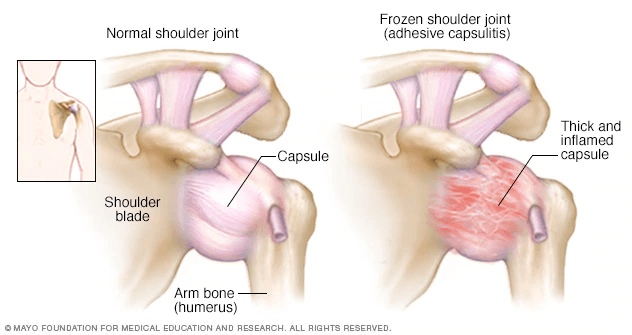What is frozen shoulder?
“Frozen shoulder, also known as adhesive capsulitis, is a condition characterized by stiffness and pain in your shoulder joint. Signs and symptoms typically begin gradually, worsen over time and then resolve, usually within one to three years” (Mayo Clinic, 2018).
What causes frozen shoulder?
There is no obvious cause of frozen shoulder. “The bones, ligaments and tendons that make up your shoulder joint are encased in a capsule of connective tissue. Frozen shoulder occurs when this capsule thickens and tightens around the shoulder joint, restricting its movement. Doctors aren’t sure why this happens to some people, although it’s more likely to occur in people who have diabetes or those who recently had to immobilize their shoulder for a long period, such as after surgery or an arm fracture” (Mayo clinic, 2018).

What are the symptoms of frozen shoulder?
The main symptom of frozen shoulder is the restriction of the patient’s range of motion. This is usually paired with pain in the shoulder and surrounding musculature. “Frozen shoulder typically develops slowly, and in three stages. Each stage can last a number of months. [In the] freezing stage, any movement of your shoulder causes pain, and your shoulder’s range of motion starts to become limited. [In the] frozen stage. Pain may begin to diminish during this stage. However, your shoulder becomes stiffer, and using it becomes more difficult. [In the] thawing stage. The range of motion in your shoulder begins to improve. For some people, the pain worsens at night, sometimes disrupting sleep” (Mayo Clinic, 2018).
How does one treat frozen shoulder?
Multiple adjustments of the Occiput and C1 vertebrae over an extended period of time may relieve symptoms and help the patient gain back their range of motion. A rehabilitation specialist or a physical therapist may provide a patient with stretches and exercises to increase range of motion and decrease pain. Over the counter medications such as Advil, Tylenol, etc. may be taken to reduce pain and inflammation. Manual/massage therapy may also aid in increasing the range of motion, reducing adhesions & release trigger points. Ultrasound therapy and electric muscle stimulation may also provide relief for the patient by healing tissue deep within the shoulder capsule. “Most frozen shoulders get better on their own within 12 to 18 months. For persistent symptoms, your doctor may suggest: Steroid injections. Injecting corticosteroids into your shoulder joint may help decrease pain and improve shoulder mobility, especially in the early stages of the process. Joint distension. Injecting sterile water into the joint capsule can help stretch the tissue and make it easier to move the joint. Shoulder manipulation under anesthesia. In this procedure, you receive a general anesthetic, so you’ll be unconscious and feel no pain. Then the doctor moves your shoulder joint in different directions, to help loosen the tightened tissue. Surgery. Surgery for frozen shoulder is rare, but if nothing else has helped, your doctor may recommend surgery to remove scar tissue and adhesions from inside your shoulder joint. Doctors usually perform this surgery with lighted, tubular instruments inserted through small incisions around your joint (arthroscopically)” (Mayo Clinic, 2018).
Work Cited
Frozen shoulder. (2018, July 20). Retrieved July 27, 2020, from https://www.mayoclinic.org/diseases-conditions/frozen-shoulder/symptoms-causes/syc-20372684
